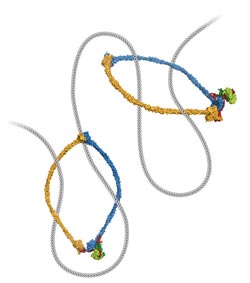What Holds Chromosomes Together – Max Planck Scientists Elucidate the Structure of DNA-Packaging Proteins

SMC protein complexes form ring-like structures that entrap DNA molecules to shape chromosomes into a series of loops or coils.<br>Copyright: MPI of Biochemistry<br>
At the Max Planck Institute of Biochemistry in Martinsried near Munich scientists have now elucidated the structure of a ring-shaped protein complex (SMC-kleisin), which ensures order in this packaging process. Together with their cooperation partners at the Korea Advanced Institute of Science and Technology, they studied these proteins in bacteria and found structural analogies to the human complex. The findings have now been published in the journal Nature Structural & Molecular Biology.
In each cell about two meters of DNA must fit into a cell nucleus that has a diameter of only a few thousandths of a millimeter. There the DNA is organized in individual chromosomes in the form of very long filaments. If they are not equally and accurately distributed to the daughter cells during cell division, this can result in cancer or genetic defects such as trisomy 21. Therefore, to ensure safe transport of DNA during cell division the long and coiled DNA fibers must be tightly packed.
Scientists have only a sketchy understanding of this step. The SMC-kleisin protein complexes play a key role in this process. They consist of two arms (SMC) and a bridge (kleisin). The arms wrap around the DNA like a ring and thus can connect duplicated chromosomes or two distant parts of the same chromosome with each other.
Learning from bacteria
Simple organisms like bacteria also use this method of DNA packaging. The scientists, in collaboration with colleagues from South Korea, have now elucidated the structure of a precursor of human SMC-kleisin complexes of the bacterium Bacillus subtilis. The researchers showed that the bacterial SMC-kleisin complex has two arms made of identical SMC proteins that form a ring. The arms differ in their function only through the different ends of the kleisin protein with which they are connected.
In humans the DNA packaging machinery is similarly organized. “We suspect that this asymmetric structure plays an important role in the opening and closing of the ring around the DNA,” explains Frank Bürmann, PhD student in the research group ‘Chromosome Organization and Dynamics’ of Stephan Gruber. In addition, the scientists discovered how the ends of the kleisin can distinguish between correct and wrong binding sites on one pair of arms.
The cohesion of chromosomes is of critical importance for reproduction as well. In human eggs this cohesion must be maintained for decades to ensure error-free meiosis of the egg cell. Failure of cohesion is a likely cause for decreased fertility due to age or the occurrence of genetic defects such as trisomy 21. “The elucidation of the structure of SMC-kleisin protein complexes is an important milestone in understanding the intricate organization of chromosomes,” says group leader Stephan Gruber. [VS]
Media Contact
All latest news from the category: Life Sciences and Chemistry
Articles and reports from the Life Sciences and chemistry area deal with applied and basic research into modern biology, chemistry and human medicine.
Valuable information can be found on a range of life sciences fields including bacteriology, biochemistry, bionics, bioinformatics, biophysics, biotechnology, genetics, geobotany, human biology, marine biology, microbiology, molecular biology, cellular biology, zoology, bioinorganic chemistry, microchemistry and environmental chemistry.
Newest articles

Webb captures top of iconic horsehead nebula in unprecedented detail
NASA’s James Webb Space Telescope has captured the sharpest infrared images to date of a zoomed-in portion of one of the most distinctive objects in our skies, the Horsehead Nebula….

Cost-effective, high-capacity, and cyclable lithium-ion battery cathodes
Charge-recharge cycling of lithium-superrich iron oxide, a cost-effective and high-capacity cathode for new-generation lithium-ion batteries, can be greatly improved by doping with readily available mineral elements. The energy capacity and…

Novel genetic plant regeneration approach
…without the application of phytohormones. Researchers develop a novel plant regeneration approach by modulating the expression of genes that control plant cell differentiation. For ages now, plants have been the…





















